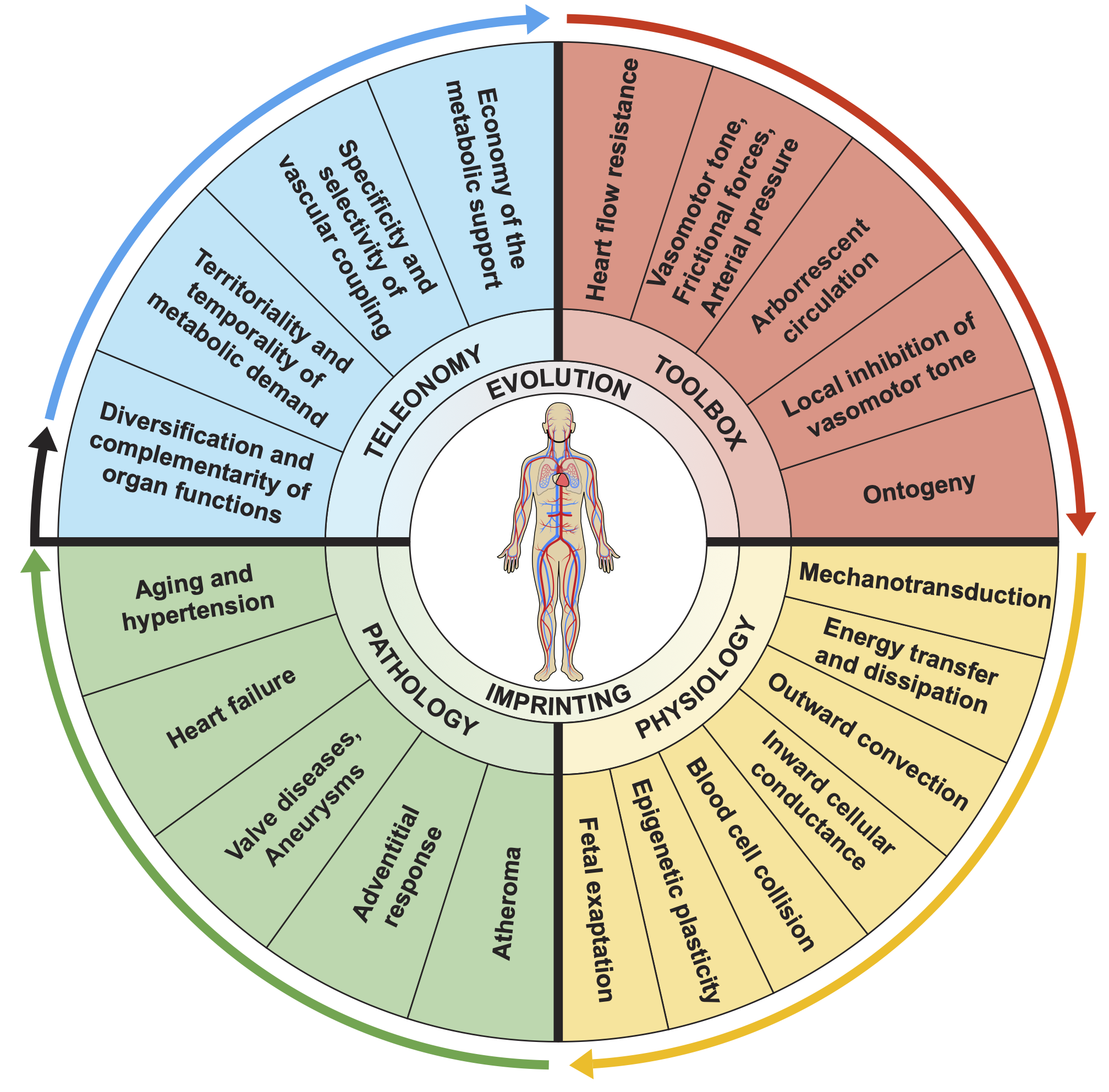Phylogenic determinants of cardiovascular frailty, focus on hemodynamics and arterial smooth muscle cells
Michel JB
2020 • Physiol Rev • [pdf]
 The evolution of the circulatory system from invertebrates to mammals has involved the passage from an open system to a closed in-parallel system via a closed in-series system, accompanying the increasing complexity and efficiency of life’s biological functions. The archaic heart enables pulsatile motion waves of hemolymph in invertebrates, and the in-series circulation in fish occurs with only an endothelium, whereas mural smooth muscle cells appear later. The present review focuses on evolution of the circulatory system. In particular, we address how and why this evolution took place from a closed, flowing, longitudinal conductance at low pressure to a flowing, highly pressurized and bifurcating arterial compartment. However, although arterial pressure was the latest acquired hemodynamic variable, the general teleonomy of the evolution of species is the differentiation of individual organ function, supported by specific fueling allowing and favoring partial metabolic autonomy. This was achieved via the establishment of an active contractile tone in resistance arteries, which permitted the regulation of blood supply to specific organ activities via its localized function-dependent inhibition (active vasodilation). The global resistance to viscous blood flow is the peripheral increase in frictional forces caused by the tonic change in arterial and arteriolar radius, which backscatter as systemic arterial blood pressure. Consequently, the arterial pressure gradient from circulating blood to the adventitial interstitium generates the unidirectional outward radial advective conductance of plasma solutes across the wall of conductance arteries. This hemodynamic evolution was accompanied by important changes in arterial wall structure, supported by smooth muscle cell functional plasticity, including contractility, matrix synthesis and proliferation, endocytosis and phagocytosis, etc. These adaptive phenotypic shifts are due to epigenetic regulation, mainly related to mechanotransduction. These paradigms actively participate in cardio-arterial pathologies such as atheroma, valve disease, heart failure, aneurysms, hypertension, and physiological aging.
The evolution of the circulatory system from invertebrates to mammals has involved the passage from an open system to a closed in-parallel system via a closed in-series system, accompanying the increasing complexity and efficiency of life’s biological functions. The archaic heart enables pulsatile motion waves of hemolymph in invertebrates, and the in-series circulation in fish occurs with only an endothelium, whereas mural smooth muscle cells appear later. The present review focuses on evolution of the circulatory system. In particular, we address how and why this evolution took place from a closed, flowing, longitudinal conductance at low pressure to a flowing, highly pressurized and bifurcating arterial compartment. However, although arterial pressure was the latest acquired hemodynamic variable, the general teleonomy of the evolution of species is the differentiation of individual organ function, supported by specific fueling allowing and favoring partial metabolic autonomy. This was achieved via the establishment of an active contractile tone in resistance arteries, which permitted the regulation of blood supply to specific organ activities via its localized function-dependent inhibition (active vasodilation). The global resistance to viscous blood flow is the peripheral increase in frictional forces caused by the tonic change in arterial and arteriolar radius, which backscatter as systemic arterial blood pressure. Consequently, the arterial pressure gradient from circulating blood to the adventitial interstitium generates the unidirectional outward radial advective conductance of plasma solutes across the wall of conductance arteries. This hemodynamic evolution was accompanied by important changes in arterial wall structure, supported by smooth muscle cell functional plasticity, including contractility, matrix synthesis and proliferation, endocytosis and phagocytosis, etc. These adaptive phenotypic shifts are due to epigenetic regulation, mainly related to mechanotransduction. These paradigms actively participate in cardio-arterial pathologies such as atheroma, valve disease, heart failure, aneurysms, hypertension, and physiological aging.

